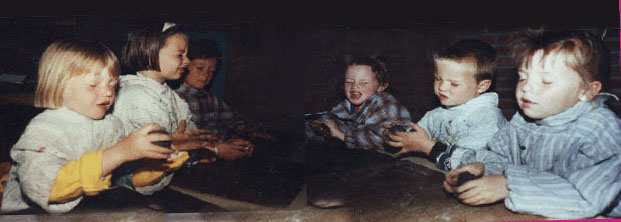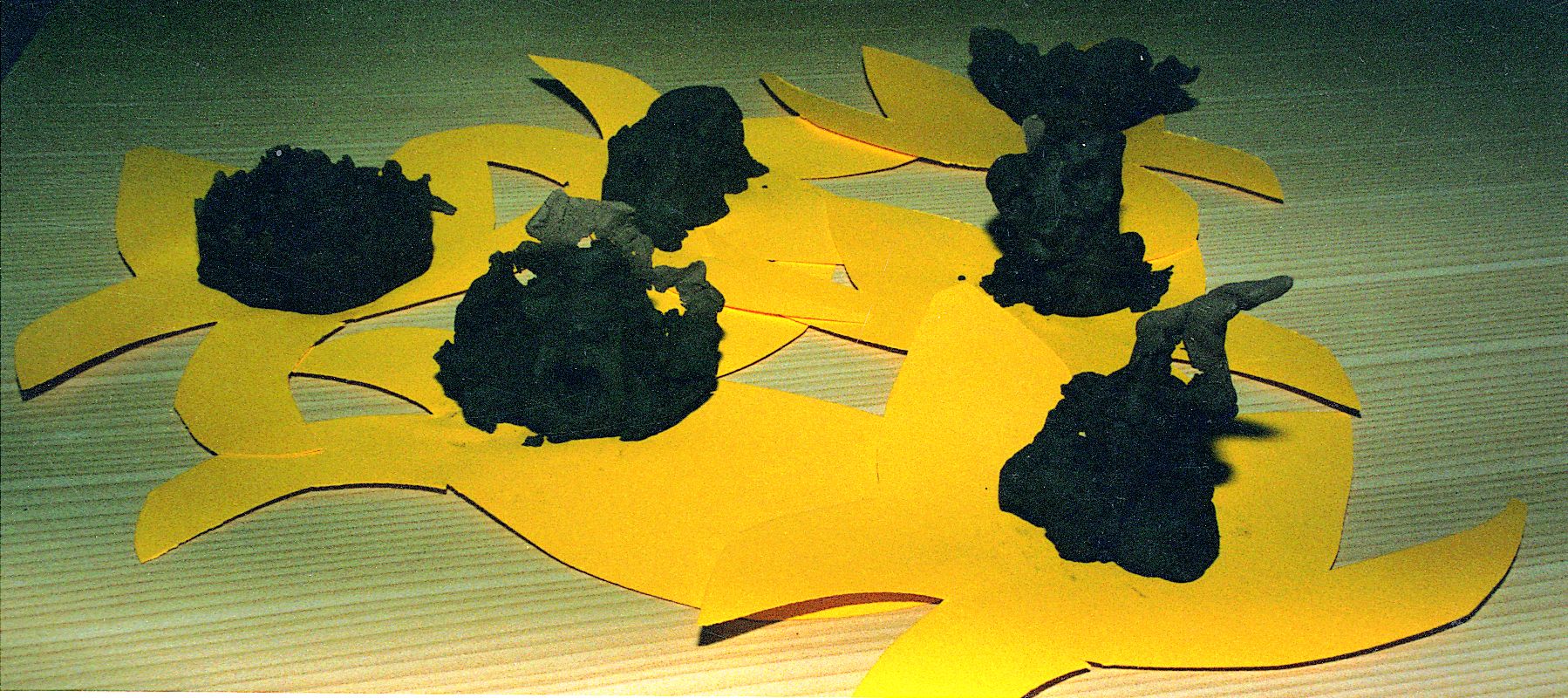The exercise: the clay exchange

The game of discoveries!
Example of an introduction to an exercise with clay from the book ‘the Timeless Hour’.
Aim
- Promotion of social interaction.
- Strengthening of body feeling.
- Experiencing giving and receiving.
- Letting go of ‘mine’ and ‘thine’.
- Transformation through continual change.
- Decisiveness and self-responsible choosing.
- Non-verbal and verbal communication.
- Promotion of group dynamics and sharing out of equality.
- Promotion of integration of the children in your group, both actively and verbally in combining of the clay figures. 10. P.L.R.S. (Promotion of integration of the left and right hand sides of the brain)
- Through social interaction unity in the group feeling of the group is created.
A play situation comes into being by means of an exchange between the children who are sitting in pairs opposite or next to each other. There is mainly non-verbal communication. Only when the exercise is finished can the pairs communicate about it with guidance from the group teacher. The body feeling is strengthened through various ways of moving and touching the clay.
If you yourself participate as group teacher. This is really only possible if there is an uneven number of children in your group.
There is an interaction between you and the children if you should participate, while at the same time verbally indicating the successive actions. As group teacher you also keep your eyes closed if you are able to instruct the exercise well by heart. This enhances the relation of trust between you and the children which also has an effect on the development of the child’s self confidence. It also creates an atmosphere of well-being in the group of children you’re working with. This exercise you would usually do when you have already worked before with these exercises with the children in your group.
The exchange comprises the theme of giving (letting go) and receiving (accepting) in the non-verbal communication. The child can determine independently whether to continue with the bit of clay it has received earlier or to completely change it. This is called positive destruction. Each child has that option (equality). The child learns to make a decision independently and to trust that decision. Through co-operation inner thoughts, feelings and ideas are exchanged non-verbally. In the final stage verbal communication also takes place when the children talk together and exchange something as they have worked in pairs.
Materials
Clay the size of a tennis ball or a bit larger, fitting in two child’s hands
Clay board 25 x 35 cm.
If the children make a drawing afterwards:
Paper 65 x 50 cm 160 grams
4 crayons (white, sienna, blue, black)
Tesa tape

An example of a playful exercise in transforming modelling
During this exercise there is no speaking except in the final stage when you as group teacher indicate the moment.
The children are sitting in groups of two next to or opposite each other. In this way they can easily exchange the pieces of clay among them in pairs. If there is an odd number of children in your group, you can do the clay exchange with one child who would otherwise be sitting on its own.
When you have handed out the clay, you first have the children knead their bit until it is supple. A clay board can be very useful. They can throw the piece of clay onto the board and hit it with their hands. This makes the clay very supple.
Often this initially leads to a rather boisterous working atmosphere. It is recommended to allow this for a little while. In many cases the group then becomes calmer which works well in creating a relaxed atmosphere in your group. A little working noise also creates an activating atmosphere. This so-called foreplay is also a way of giving the children some options of expression as they almost always react enthusiastically to working with clay.
Then they close their eyes and with both hands start kneading the clay intuitively. They can express themselves through hitting the clay and making noises with their voice. Especially if they have just received the clay object after the ‘exchange’. However, there is no talking, so no judgments can be voiced within the group which could be disruptive.
You as coach/mediator indicate the exchange each time by saying the word ‘exchange’. In the beginning the ‘exchange’ is a little faster, but in such a way that the periods of time are never the same, so there is no habituation. The periods of time may become consecutively longer. Maybe once or twice an exchange that is a bit faster.
Usually this exercise does not take much longer than 15 to 20 minutes in total. If you feel that the level of concentration is high, you can let de exercise continue longer. You determine whether you tell the children the duration of the exercise beforehand.
Explain clearly to them:
“Take the clay board and sit down on the floor in pairs. You sit down in a way that you can still see me. After I have said the word ’exchange’, you first give the clay object to each other. When you have received the clay object, you first thoroughly feel it with your hands. You do not start changing it immediately. Feel it for about 8 to 10 seconds, without changing anything. Now and then you can also sit without moving your hands and just holding the clay object. You do not have to be active all the time.”
In the exercise ‘clay exchange’ in pairs the giving (letting go) and receiving (taking in) are an important part. Here the ‘mine’ and ‘thine’ plays a key role. After a number of exchanges both pieces of clay represent the work of both children. Also not controlling through the eyes, but feeling everything by touch, may be accompanied by a stimulation of the child’s visualisation ability. The choice to ‘continue with …’ or ‘change into …’ is a strong stimulus for the child as it decides itself whether to change and thereby develops a feeling of self-responsibility.
Just as in the collective drawing exercises it is important to clearly explain to the children in advance the difference between ‘mine’ and ’thine’. This is aimed at their learning to deal with the feeling of ‘mine’ and ‘thine’ in letting go of ‘my’ clay object and accepting and/or changing the ‘other’ clay object, ’thine’. The game of discoveries!
Instruction
Tell the children the following clearly:
“The clay object is for ‘you’ but not ‘yours’…, and also for ‘you’ and for ‘you’, but not ‘yours’, so no one owns either of the two clay objects.”
Every time you use the word ‘you’, you indicate a different child, so it is clear to all children that this applies to all of them.
When you explain the ‘exchange’ it becomes clear that the exercise does not have a specific form or theme. Because if you say the word ’exchange’ once more or once less, the image keeps changing. The final ‘exchange’ determines the final image.
Exercise 1
Tell the children: “Close your eyes, feel the clay in your hands and do with it what your hands want to do. Do keep the clay at your workspace in your hands or on the clay board or the floor”
From now on you keep saying: ‘exchange’…’exchange’…’exchange’……….
You determine how often you let the children exchange. After the children have exchanged their clay objects, you now and then within 15 seconds softly say the following sentences:
“Relax behind your eyes”
“Let go when you breathe out”
Exercise 2
After having said the last ‘exchange’ you softly but clearly audible tell the children:
“Keep your eyes closed for a while
With both hands bring the piece of clay to your face and softly touch it to your forehead.
Then open one eye very slightly so you can just see something of the clay and of your fingers.
Look at the light and dark areas of the clay and also look at your fingers, your skin, your nails and whatever else you see.
Gradually let some more light come into your eyes.
You now see more of the clay, look into the cracks and holes in the clay and discover what there is to see.
See if in this half twilight you can find a place where you can sit safely and comfortably
Try and find for instance a cavity or a tear or a top of a hill
Once your eyes are completely open, let your hands holding the clay figure rest in your lap.
Stay sitting like that for a while. From now onwards you don’t change the clay figure any more”
This concludes the practical part of this exercise. If you a group teacher wish to make time available, you can let the dialogue take place now. However, you may also decide to continue after the exercise without having the dialogue.

You may decide to follow the above exercise with one or two of the exercises given below and say to the children:
- “Now, as you are sitting in pairs, show the clay figures to each other.
- Then tell each other what you see in the last clay figure …You can also tell each other what you have experienced during the clay exchange (this does not happen in the group)
- Finally you can each think of a name or a title for the clay figure you have in your hand …The title can be no longer than three words.”
After this, you can let each child in turn clearly state the title they have come up with. As they are doing this, you ask the child to hold the clay figure up in the air a bit, so the other children can see it better.
- “Put the clay figure down next to you. Now you will make a drawing in crayon with your eyes closed, based on the most important experience you had while working with the clay with your eyes closed. You make the drawing with the hand you usually do not write with. The drawing does not have to resemble anything; you cannot expect it to.”
- “Put the clay figure down next to you. You will now make a drawing in crayon with your eyes closed, based on the clay figure after the last exchange. You make the drawing with the hand you usually do not write with. The drawing does not have to resemble anything, you cannot expect it to.”
6a. “Don’t change the clay figures any more. Now put the two clay figures close to each other and make a composition of the two figures. First try out several positions of the figures in relation to each other, to find the right position. Meanwhile you tell each other what you see in these new compositions. Finally you give a name to the final composition you think the best. The name or title has no more than three words.”
6b. “Now you can combine all separate clay figures into one large common clay sculpture. You can do this on the floor or on the table.”
Or
6c. “You can now put the compositions from 6a together to form one large common clay sculpture. You can do this on the floor or on the table.”

Gevoelscontact in diepe concentratie.
